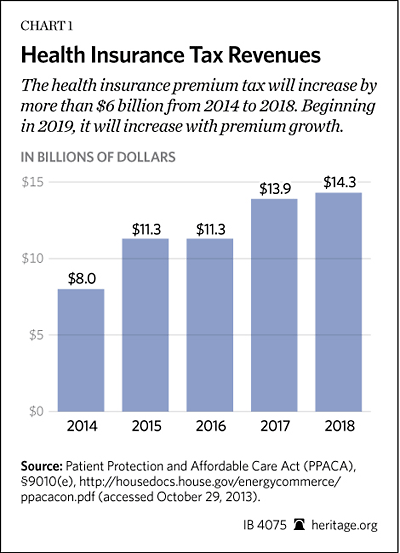Obamacare imposes a new tax on health insurance premiums, starting in 2014, that will increase individual and small group health insurance premiums by an additional 2–3 percent. This will have an adverse impact on consumers and reduce employment but have little impact on large employers and their employees, because large firms usually self-insure. The tax is hidden from consumers, and it should be repealed.
How the Health Insurance Tax Works
The IRS calls the new excise tax a “Health Insurance Provider Fee.”[1] Opponents call it the health insurance tax (HIT).[2]
The tax is not imposed at a specified rate; rather, the effective rate is set annually by the Treasury to raise a specified amount of revenue. The amount of revenue to be raised is shown in the table below.

Thus, the amount of tax revenue raised will increase substantially over time. The tax will raise 79 percent more revenue in 2018 than in the initial year, 2014, and will increase still further thereafter.
The tax is imposed on net health insurance premiums for any United States health risk to the extent the insurer’s premiums exceed $50 million annually.[3] The tax is not tax deductible, which raises its effective tax rate by 54 percent.[4]
Most Large Employers and Their Employees Are Exempt
Employers that self-insure are explicitly exempted from the tax. Most large employers self-insure, while most small employers do not. Thus, this tax will affect almost exclusively small businesses and individual consumers. In 2011, 86.3 percent of employers with 1,000 or more employees were in self-insured plans. About 35 percent of employers with 100–999 employees self-insured and less than 13 percent of employers with fewer than 100 employees self-insured.[5]
Generally, with self-insured plans, the employer establishes a trust and contributes money to the trust. Employee health care costs are paid in accordance with the trust or plan document. The employer will often use a third party to administer the health care plan. Usually, the plan uses a preferred provider network or other network of health care providers to contain costs. Small or mid-size employers that self-insure usually purchase stop-loss insurance that limits either their aggregate or per-person losses or both. In all of these cases, self-insurers are exempt from the tax.
The table below summarizes the findings of three studies of the impact of the health insurance tax on health insurance premiums. The results vary because of (1) differing data sources and estimates about the amount of health insurance premium revenue that insurance companies will have in 2014 and thereafter, and (2) differing estimates about how many firms will move toward self-insurance rather than buying health insurance over time. Each is clear, however, that the tax imposes more costs on consumers.

It is generally agreed that the economic incidence of the tax will fall on consumers and small employers.[6] The higher costs that small employers face will tend to reduce employment. A study by the National Federal of Independent Business Research Foundation found that the health insurance tax will reduce private-sector employment by 146,000 to 262,000 jobs in 2022.[7]
Because of the health insurance tax, the health insurance underwriting restrictions in Obamacare (notably the age bands limiting the ratio of the premiums for the oldest workers to no more than three times those for the youngest workers), and the Essential Health Benefits requirements for health insurance, it is very likely that a large number of employers will find self-insurance to be an increasingly attractive option under Obamacare. This effect will be particularly pronounced for employers with relatively young and healthy employee populations.
To the extent this movement toward self-insurance occurs, it will reduce the amount of premiums underwritten (i.e., the size of the taxable base for the health insurance tax) and increase the required health insurance effective tax rate to raise the set dollar amounts that must be raised (see table above). The higher effective tax rate will increase the percentage by which premiums must increase in subsequent years.
A Hidden Tax
Because the tax is an annual tax paid by insurance companies, it is effectively hidden from health insurance buyers, including both individual consumers and small employers. The health insurance tax, of course, is just one of many reasons that premiums will increase under Obamacare.[8]
—David R. Burton is Senior Fellow in Economic Policy in the Thomas A. Roe Institute at The Heritage Foundation.



